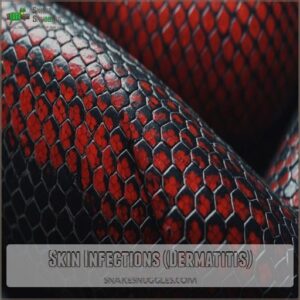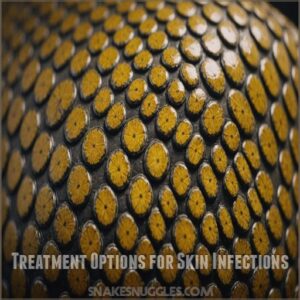This site is supported by our readers. We may earn a commission, at no cost to you, if you purchase through links.

Keep your pet snake slithering smoothly by making sure proper humidity is in its habitat.
Prevent skin issues with a balanced diet, as healthy scales start from the inside.
When problems pop up, consult a vet for treatments like antibiotics or antifungal meds.
Wound care is essential—think of it as a mini snake spa!
Catching problems early, like mouth rot or scale infections, ensures quicker recovery.
Get into these slippery details, and you’ll soon have a hiss-terically happy snake lounging in style.
Curious for more skin-care secrets? Stay tuned!
Table Of Contents
- Key Takeaways
- Recognizing Snake Skin Problems
- Causes of Snake Skin Problems
- Creating a Healthy Habitat for Snakes
- Preventing Snake Skin Problems
- Specific Snake Skin Conditions
- Shedding and Skin Renewal in Snakes
- Treatment Options for Skin Infections
- Advanced Care for Snake Skin Issues
- Veterinary Care and Maintenance for Healthy Skin
- Managing Chronic Skin Conditions
- Frequently Asked Questions (FAQs)
- How do you treat a snake infection?
- What is the recommended line of management for rattle snake bite in humans?
- How do you treat a cut on a snake?
- How do I stop a snake from rubbing his face?
- Do snakes have skin problems?
- What to do if a snake has blisters?
- How do you treat a snake skin infection?
- How to get rid of snake skin?
- Can snake skin be repaired?
- What triggers ichthyosis?
- How do I safely handle shedding issues?
- What natural remedies help with snake mites?
- How long does a skin infection take to heal?
- Can improper lighting affect my snakes skin?
- What are signs of an allergic reaction in snakes?
- Conclusion
Key Takeaways
- Catch skin issues early, keep an eye out for redness, blisters, or shedding problems, and consult a vet for prompt treatment.
- Ensure a clean habitat by maintaining proper humidity and temperature to prevent infections and skin irritation.
- Offer a balanced diet rich in essential nutrients to support your snake’s overall skin health and prevent nutritional deficiencies.
- Use antibiotics for bacterial infections and antifungal treatments where needed, and always follow a vet’s guidance for effective care.
Recognizing Snake Skin Problems
You’re not just a snake owner; you’re a scale sleuth on the lookout for trouble.
Knowing the signs of snake skin problems, like redness, blisters, or shedding issues, can help you catch and treat issues early, keeping your slithery friend healthy and happy.
Common Skin Issues in Snakes
Your slithery friend’s skin is their first line of defense, but it’s not invincible.
Common skin issues can sneak up on snakes, so keep your eyes peeled.
Here are three trouble-makers to watch out for:
- Scale rot: The sneaky bacterial infection that turns scales into a mushy mess
- Mites: Tiny vampires that feast on your snake’s blood
- Fungal infections: The unwelcome fuzzy guests that love damp spots
Don’t let these problems get under your snake’s skin.
Regular check-ups are key to keeping your scaly pal healthy and happy.
Symptoms of Skin Infections
Now, let’s talk about the red flags of snake skin infections.
Keep an eye out for skin lesions, which can be like tiny battle scars on your scaly friend.
Redness and blisters might pop up, looking like your snake’s been through a rough patch.
If you spot pus discharge, that’s a clear SOS signal.
Scaling beyond normal shedding is another tell-tale sign.
These symptoms can indicate bacterial, parasitic, or viral skin infections, so stay vigilant!
Early Detection of Skin Problems
Keeping an eagle eye on your snake’s skin can be a real lifesaver.
Get up close and personal with your scaly friend daily, looking for any odd bumps, blisters, or discoloration.
Caught early, skin problems are much easier to treat.
Watch for signs of shedding trouble too – if your snake’s struggling to slip out of its old skin, it’s time to step in.
Regular vet visits are key to staying ahead of snake fungal disease and other sneaky issues.
Causes of Snake Skin Problems
Your snake’s skin troubles might be sneakier than a serpent in the grass, with environmental factors, poor hygiene, and nutritional gaps playing hide-and-seek in your pet’s habitat.
By understanding these sly culprits, you’ll be better equipped to keep your scaly friend’s skin as smooth as a freshly shed coat.
Environmental Factors Affecting Skin Health
Let’s talk about how your snake’s home affects its skin health. It’s like a balancing act!
The right substrate choice can prevent scale rot, while proper humidity control helps with smooth shedding.
Create a temperature gradient so your snake can regulate its body heat.
Good ventilation wards off fungal diseases, and proper lighting keeps bacterial infections at bay.
Remember, a happy habitat means a happy, healthy snake!
Poor Habitat Hygiene and Its Effects
While environmental factors play a role, a dirty snake home is like inviting trouble over for dinner.
Mite infestations, bacterial infections, and scale rot love to crash the party in unkempt habitats.
You’ll see skin irritation, shedding problems, and even respiratory issues crop up.
It’s not just about looks – poor hygiene can turn your snake’s sanctuary into a breeding ground for fungal disease and snake mites.
Keep it clean to keep your scaly friend healthy!
Nutritional Deficiencies and Skin Issues
Your snake’s diet plays a starring role in its skin health.
Calcium deficiency can lead to shedding problems, while a lack of Vitamin A might cause skin conditions.
Think of prey size as a Goldilocks situation – not too big, not too small.
Nutritional supplements can be a game-changer, but don’t go overboard.
Remember, a balanced diet is your best defense against snake skin diseases.
It’s like feeding your scaly friend a five-star meal for their skin!
Creating a Healthy Habitat for Snakes
You’re about to become a snake habitat architect, and trust me, it’s more fun than it sounds!
Creating a healthy home for your scaly friend isn’t just about tossing them in a box with some dirt – it’s about crafting a mini paradise that’ll keep their skin sleek and their spirits high.
Proper Temperature and Humidity Levels
Creating a cozy home for your scaly friend is key to preventing skin issues.
Think of it like a snake spa: you’ve got to nail the temperature and humidity.
Set up a temperature gradient so your snake can choose its perfect spot.
Keep the humidity just right to avoid shedding nightmares and scale rot.
Here’s your snake habitat checklist:
- Install a reliable thermometer and hygrometer
- Create basking spots with heat lamps or ceramic heaters
- Use a misting system for precise humidity control
- Make sure you have proper ventilation to prevent fungal growth
Suitable Substrates for Snakes
Now that you’ve got the temperature and humidity dialed in, let’s talk snake bedding.
The right substrate can make or break your snake’s skin health.
Think of it as their personal spa treatment!
Natural options like aspen or cypress mulch mimic their wild habitat and help maintain moisture.
But watch out – some substrates can harbor nasty bacteria or parasites.
Keep it clean and dry to prevent fungal party crashers.
Your scaly friend will thank you with a shiny, healthy coat!
Heating and Lighting Considerations
While the right substrate keeps your snake comfy, proper heating and lighting are the real game-changers.
You can find a great snake basking lamp to help create basking spots and thermal gradients.
Set up UVB lighting and heat lamps to create basking spots and thermal gradients. This mimics their natural habitat and helps prevent snake skin problems like scale rot.
Remember, night time temperatures should drop slightly. It’s like giving your scaly friend a cozy day-night cycle, reducing stress and promoting healthy shedding.
Who knew being a snake spa designer could be so fun?
Preventing Snake Skin Problems
You’re about to become a snake skin detective, and trust us, it’s more fun than it sounds!
By learning to spot early signs of trouble and keeping your scaly friend’s diet on point, you’ll be well on your way to preventing those pesky skin problems that can make your snake feel less than fabulous.
Regular Skin Inspections and Checks
Don’t let skin issues slither by unnoticed.
Keep a close eye on your scaly friend’s skin health with regular inspections.
Look for early signs of trouble like redness, blisters, or swelling.
Check for mites, those pesky hitchhikers, and watch for shedding problems, as issues like these can be a sign of snake shedding problems.
Providing a Balanced Diet for Snakes
Your snake’s skin health starts in its belly!
A balanced diet is key to preventing nutritional deficiencies that can lead to skin problems.
Think of it as your snake’s internal skincare routine.
Provide a variety of prey that meets your snake’s calcium and vitamin needs.
You might need to sprinkle in some dietary supplements, like a snake multivitamin.
Remember, a well-fed snake is a happy, healthy snake with a glowing, problem-free coat!
Safe Prey Options and Feeding Frequency
Feeding your snake isn’t just about tossing in any old mouse.
It’s a balancing act that can make or break your pet’s skin health.
Let’s slither into some smart feeding practices:
- Match prey size to your snake’s girth
- Mix up the menu with varied prey types
- Stick to a consistent feeding schedule
Remember, frozen prey is often safer than live options.
It’s like meal prepping for your scaly friend – convenient and reduces the risk of injuries that could lead to skin infections.
Specific Snake Skin Conditions
You’ve got your snake all set up in a cozy habitat, but sometimes those scaly friends can still run into skin trouble.
From pesky parasites to tricky infections, let’s explore the common skin conditions that might make your serpent squeeze feel less than stellar.
Infectious Stomatitis (Mouth Rot)
While we’ve been talking about preventing skin issues, let’s address a serious condition that can sneak up on your scaly friend: infectious stomatitis, or "mouth rot."
This bacterial infection can be a real pain in the neck for your snake, causing inflammation and ulcers in their mouth.
It’s no laughing matter, but with quick action, you can help your pet bounce back.
This condition, also known as mouth rot, can even lead to severe complications, so you’ll want to keep a close eye on your snake.
| Symptom | What it Means for Your Snake |
|---|---|
| Drooling | Your snake’s crying out for help |
| Red, swollen gums | Their smile’s not so happy |
| Loss of appetite | Dinner’s lost its appeal |
| Cheesy discharge | A not-so-tasty surprise |
| Bad breath | Their kiss is worse than their bite |
Remember, early detection is key. If you spot these signs, don’t wait – slither over to your reptile vet pronto. They’ll likely prescribe antibiotics and show you how to clean your snake’s mouth. With proper care, you’ll have your serpent friend flicking its tongue happily in no time!
Internal and External Parasites
Just when you thought mouth rot was a handful, parasites slither into the picture!
These tiny troublemakers can wreak havoc on your snake’s skin.
Let’s tackle these unwelcome guests head-on:
- Mites: These microscopic menaces can cause intense itching and skin irritation.
- Ticks: These bloodsuckers can lead to anemia and transmit diseases.
- Internal parasites: They may not be visible, but they can cause weight loss and shedding issues.
Regular check-ups and proper hygiene are your best weapons in this creepy-crawly battle!
Skin Infections (Dermatitis)
Ever noticed your snake’s skin looking a bit less like a smooth, shiny jacket and more like a patchy quilt?
Dermatitis might be the culprit.
Common symptoms include redness, scaling, or blisters.
Prevention tips? Keep that habitat clean and humidity just right.
Treatment options range from topical antibiotics to antifungals.
Stay vigilant, and your slithery friend will slither happily!
Respiratory Disease and Infections
Skin issues can sneak up as respiratory infections, lurking like a silent predator in your snake’s habitat.
Symptoms such as wheezing, mucus, and lethargy signal trouble.
Prevention is your first line of defense; maintain proper humidity and hygiene.
Catch signs early and seek veterinary diagnosis and treatment.
Managing these conditions helps your scaly friend breathe easy, keeping its scales healthy and gleaming.
Shedding and Skin Renewal in Snakes
When your snake goes through shedding, it’s like an extreme makeover for their scales, revealing a fresh and shiny layer underneath.
However, if they struggle with shedding, you might end up spending more time massaging stubborn skin than binge-watching your favorite series!
Normal Shedding Process in Snakes
Imagine your snake as a fashionista, routinely shedding old skin to reveal a fresh look.
This shedding cycle is natural, helping with snake skin renewal and overall skin health.
Typically, shedding frequency depends on age and growth rate.
Maintain good humidity levels to ensure smooth shedding.
It’s like giving your snake the perfect spa day for that glowing, new skin!
Shedding Problems and Causes
Mysterious shedding woes? They can often trace back to low humidity levels, stress factors, or even dietary issues.
When your snake can’t shed smoothly, those stuck sheds spell out discomfort.
An enclosure too small or unwelcome guests like parasites may also disrupt the shedding process.
Keep a watchful eye to prevent scale rot or snake skin infections from fungal disease, ensuring your pet’s skin renewal remains a natural wonder.
Assisting Your Snake With Shedding
Worried about stuck sheds? Understanding the snake skin shedding process is key to preventing issues.
Maintaining ideal humidity levels in your snake’s habitat, typically between 50-70% optimal shedding humidity, can encourage smooth shedding.
If shedding problems persist, consider soak times to gently aid the process.
Make sure your snake’s dietary needs support skin health, avoiding scale rot.
Regular inspections help spot issues early.
Treatment Options for Skin Infections
So, your scaly friend’s got a skin infection?
Luckily, there are several treatment options available, including antibiotics for bacterial infections, antifungals for fungal issues, and even wound care or laser therapy for more serious cases.
Antibiotic Therapy
Some days, you notice your snake’s skin isn’t as smooth.
Antibiotic therapy could be the ticket to smooth, healthy scales.
Keep these in mind:
- Antibiotic dosage: Just enough to be effective, not too much.
- Side effects: Monitor for these little surprises.
- Resistance: Rotate medications to dodge this sneaky issue.
Your scales will thank you!
Antifungal Medications
When your scaly buddy faces snake skin fungal infections, antifungal medications become your battle gear.
Understand types of antifungals, dosage guidelines, and possible side effects.
Also, don’t overlook over-the-counter options for simpler cases.
With snake fungal disease, timing’s everything!
Here’s a quick guide:
| Type | Uses | Cautions |
|---|---|---|
| Topical | Mild cases | Avoid eyes |
| Oral | Severe infections | Digestive upset |
| OTC Creams | Initial stages | Check expiration |
Stay sharp, prevent snake skin problems!
Wound Care and Laser Therapy
Imagine your snake needing a bit of TLC.
That’s where wound care and laser therapy step in!
They’re like the dynamic duo in battling skin infections and injuries.
Wound care techniques clean and protect, while laser therapy benefits include speeding up the healing process.
But remember, like any superhero sidekick, laser therapy types could have risks.
Choose wisely for your slithery friend’s sake!
Advanced Care for Snake Skin Issues
When your snake’s skin issues demand more than the usual TLC, you might need to explore advanced solutions like surgical interventions or experimental treatments.
These cutting-edge approaches can be the superhero your snake needs to combat pesky skin problems and slither back to its scaly best.
Surgical Interventions for Skin Problems
Jumping from traditional treatments, sometimes more advanced measures like surgical interventions are the answer for stubborn snake skin problems.
You’re looking at options such as skin grafts, laser surgery for tissue repair, or even amputation for severe cases.
These techniques aren’t the norm but can become essential when lesser solutions falter.
Keep your vet closely involved for the best outcomes.
Experimental Treatments for Snake Skin Conditions
You’ve explored surgical interventions, but what’s next for snake skin woes?
Meet the cutting-edge: stem cell therapy and gene editing.
In cases of severe fungal infections, understanding the role of Ophidiomyces ophiodiicola can be important in developing targeted treatments.
These experimental treatments aim to rejuvenate scales, tackling stubborn snake skin conditions.
Imagine plasma and phage therapy,
Veterinary Care and Maintenance for Healthy Skin
Regular vet visits are your best friend for preventing major snake skin problems; think of it as a proactive approach to keeping your scaly pal happy and healthy.
Early detection through checkups means quicker treatment and less stress for both of you, so schedule those appointments!
Regular Veterinary Checkups and Assessments
While advanced care methods might be on your radar, don’t skip regular veterinary checkups.
These visits help you with early detection and treatment options for snake skin infections, keeping snake health on track.
Imagine your vet like a detective, always sniffing out hidden snake skin disorders.
Regular checkups offer vital preventative care and husbandry advice for maintaining overall snake skin health.
Isolating The Snake for Recovery
Imagine your snake needs its personal recovery retreat.
It’s essential for stress management and preventing the spread of infection.
When setting up this space, consider following established snake health: quarantine procedures to create a safe environment.
Here’s how to do it:
- Quarantine protocols: Isolate your snake in a separate tank.
- Provide a calm recovery environment: Aim for a quiet, low
Habitat Cleaning and Disinfection
When you’re cleaning your snake’s habitat, think of it like preparing your kitchen for dinner—spotless!
Use reptile-safe cleaners and stick to disinfection protocols.
Regular habitat sterilization prevents nasty skin infections.
Humorously, a clean home means a happy snake, free from bacteria.
Try this hygiene habit:
| Step | Frequency |
|---|---|
| Spot Clean | Daily |
| Deep Clean | Monthly |
| Disinfect | Weekly |
| Check Substrate | Bi-weekly |
| Replace Water | Daily |
Managing Chronic Skin Conditions
Managing chronic skin conditions in your snake can feel like juggling a slippery, scaly puzzle, but with the right long-term treatment plans, you’re on the right track.
Regularly monitoring their skin and taking them to the vet for checkups—don’t worry, it’s not as intense as a mystery thriller, but it keeps your pet’s skin healthy!
Long-term Treatment Plans
Your snake needs a stable routine to conquer chronic skin conditions. Long-term treatment plans are all about consistency.
For an effective treatment, consider consulting products designed for reptile skin care, such as those offered at reptile skin solutions.
Here’s how you can give them the care they deserve:
- Medication schedules – Stick to a routine.
Monitoring for Skin Issues
Stay sharp on spotting skin changes! Check for unusual shedding issues and behavioral signs that might hint at underlying snake skin problems. Don’t let mites party on your pet—regular inspections help nip these in the bud. Look for color variations indicating potential scale rot or infections. Be a skin detective for your slithering companion’s health!
| Issue | What to Look For |
|---|---|
| Skin Changes | Redness or swelling |
| Shedding Issues | Stuck sheds |
| Behavioral Signs | Lethargy, aggression |
| Mite Detection | Tiny black dots |
Preventative Care and Veterinary Checkups
Regular vet visits are your best defense against chronic snake skin conditions.
Think of it as a yearly checkup for your scaly friend!
Early detection means quicker treatment, saving you stress and your snake discomfort.
A veterinarian with reptile expertise and experience is essential in identifying potential issues before they escalate.
Preventative snake skin care includes proper husbandry practices: consistent cleaning, ideal humidity, and a balanced diet.
Frequently Asked Questions (FAQs)
How do you treat a snake infection?
First, consult a vet for an accurate diagnosis.
They’ll likely prescribe antibiotics for bacterial infections or antifungals for fungal ones.
Keep the habitat clean and stress-free, and monitor for improvements.
Remember, their scales need TLC too!
What is the recommended line of management for rattle snake bite in humans?
If a rattlesnake bites you, calm yourself and call emergency services immediately.
Keep the bite area still and below heart level.
Avoid ice, cutting the bite, or using a tourniquet—trust the professionals instead.
How do you treat a cut on a snake?
Imagine patching a tiny dragon’s scales!
Start by cleaning the wound with antiseptic.
Then, apply a reptile-safe antibiotic ointment.
Keep the habitat clean and humidity balanced to promote healing.
Regular vet checks help a swift recovery.
How do I stop a snake from rubbing his face?
To stop your snake from rubbing its face, make sure the enclosure’s humidity and temperature are just right.
Check for tight spots or skin shedding issues.
A comfortable habitat keeps your snake content and injury-free!
Do snakes have skin problems?
Seriously, yes!
Snakes, like us, get skin issues.
Watch for redness, blisters, or trouble shedding.
Regular checkups with a vet are key for a happy, healthy snake.
Early detection prevents bigger problems.
What to do if a snake has blisters?
If your snake’s got blisters, act fast!
Check their habitat‘s humidity and cleanliness.
You might need a vet for antibiotics or cleaning advice.
Regularly inspect your snake for early signs to keep them comfy and healthy.
How do you treat a snake skin infection?
Catch skin infections early, like a snake shedding its old skin for new.
Use antibiotics or antifungal treatments, make sure proper habitat hygiene is maintained, and adjust humidity.
Regular vet checkups are key.
Keep things clean to prevent recurrences!
How to get rid of snake skin?
To remove snake skin, let your scaly friend wriggle through damp towels or decorate its tank with rough surfaces like rocks and branches.
They’ll handle the shedding like a pro, but make sure humidity’s just right for comfort.
Can snake skin be repaired?
Snake skin can often be repaired through proper care and treatment.
Maintain a clean habitat, make sure humidity and temperature are appropriate, and consult a vet for skin infections.
This helps your snake shed smoothly and heal effectively.
What triggers ichthyosis?
Imagine your skin as armor with cracks; ichthyosis causes scaly skin, mainly due to genetic factors.
Environmental factors like dry weather and harsh soaps also play a role.
Moisturizers and gentle care can help manage its effects.
How do I safely handle shedding issues?
Struggling with snake shedding issues?
Keep the habitat humid and inspect for stuck skin.
Offer a rough surface for your snake to rub against.
Use shedding aids for assistance, and make sure your snake is properly hydrated to support healthy shedding.
What natural remedies help with snake mites?
Unfortunately, there aren’t any proven natural remedies for snake mites. You’ll need a vet-approved treatment. Early detection is key; don’t delay seeking professional help!
How long does a skin infection take to heal?
Healing time for a skin infection can vary, typically ranging from a few days to several weeks.
It depends on factors like infection severity, treatment type, and your snake’s overall health.
Quick action and proper care accelerate recovery!
Can improper lighting affect my snakes skin?
Imagine your snake basking under the perfect light.
Improper lighting can disrupt their natural cycle, causing skin issues like poor shedding.
Make sure you have the right balance of UV light and heat for a healthy, happy reptile.
What are signs of an allergic reaction in snakes?
Your snake might show signs of an allergic reaction through symptoms like excessive scratching, redness, swelling, or respiratory trouble.
Keep an eye out for sudden behavior changes or skin hives, and consult a vet promptly.
Conclusion
Think of snake skin care like tuning a fine instrument; every detail counts.
Keep your snake’s scales healthy by recognizing snake skin problems early, understanding the causes, and taking action with proper treatments.
Create a balanced habitat with the right humidity and diet, and don’t hesitate to consult a vet when complications arise.
With these expert tips, you’ll make sure your snake slithers smoothly and happily, equipped to tackle any skin issues that come its way.





















